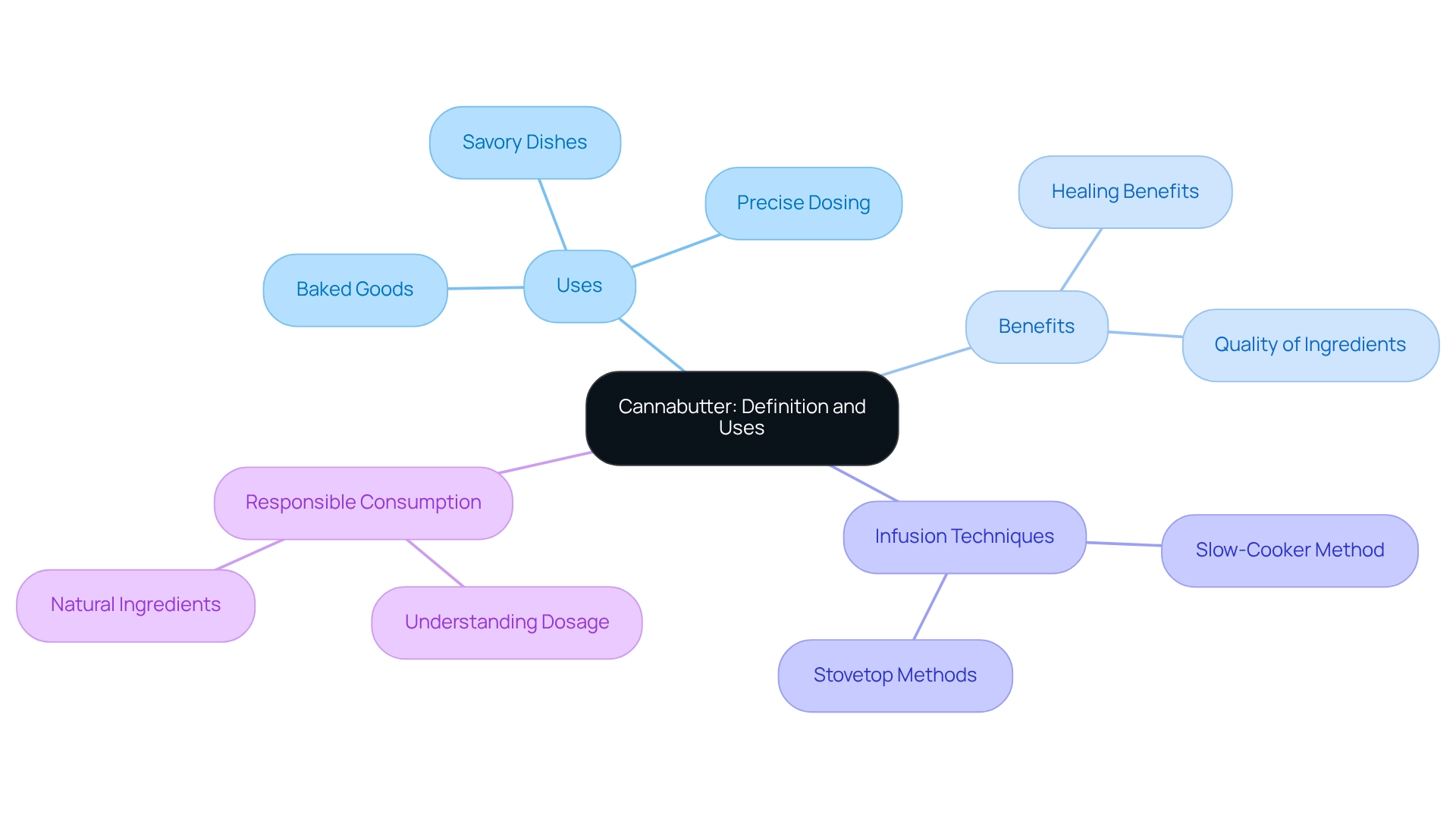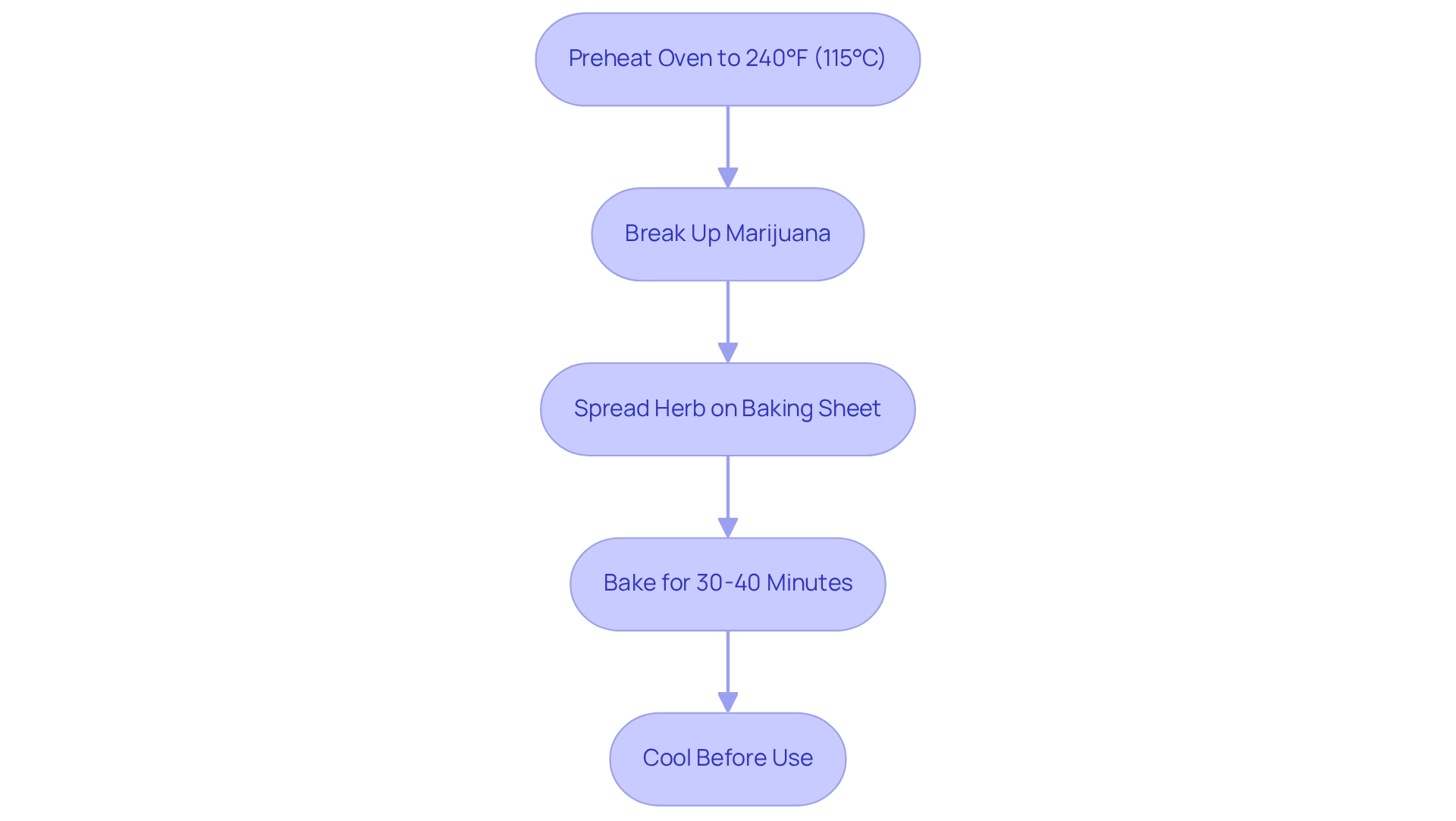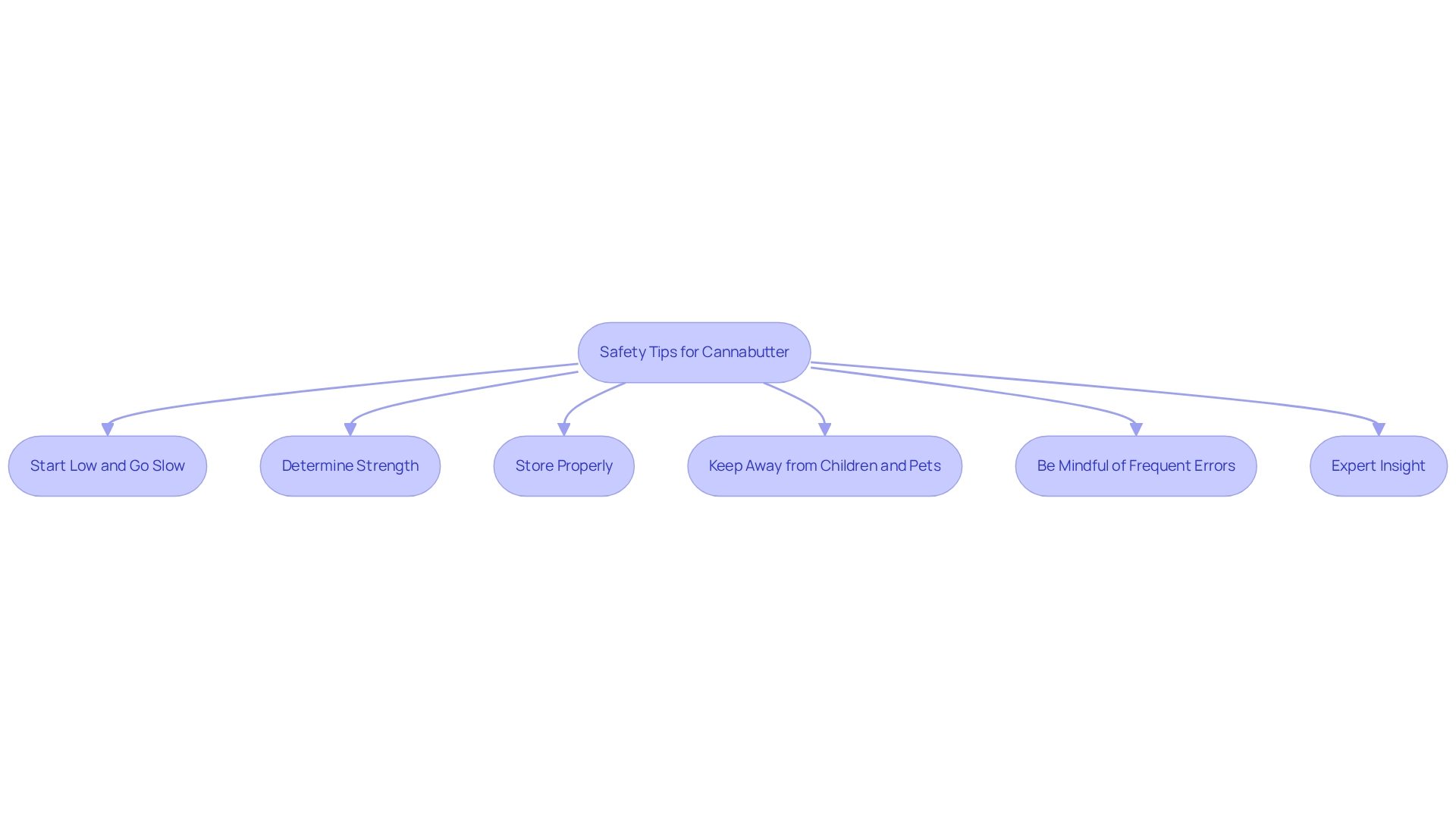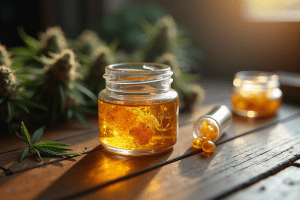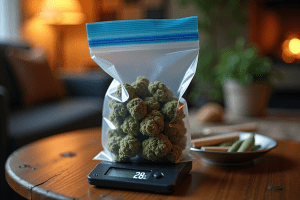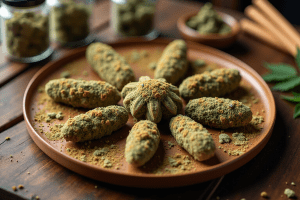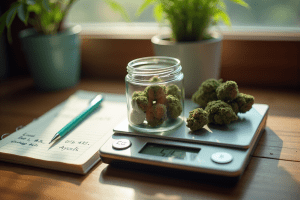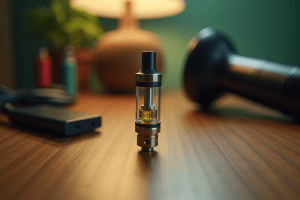Overview
This article serves as a caring and comprehensive step-by-step guide to making weed butter, specifically designed for new consumers eager to explore cannabis cooking.
We start by understanding the essential process of decarboxylation of cannabis, leading into the infusion with butter.
It’s crucial to highlight the importance of managing dosage and practicing responsible consumption, as this ensures a safe and enjoyable experience for everyone involved.
Together, let’s embark on this culinary journey with mindfulness and care.
Introduction
In the culinary world, a new trend is emerging that beautifully combines the art of cooking with the benefits of cannabis: cannabutter. This cannabis-infused butter is not just a flavorful addition to a variety of recipes; it also serves as a gateway for many to explore the therapeutic properties of cannabis in a delicious and enjoyable way.
Have you ever thought about how this could enhance your cooking? From sweet treats like cookies and brownies to savory dishes, the versatility of cannabutter opens up a realm of possibilities for home cooks and cannabis enthusiasts alike.
As the popularity of cannabis cooking grows, it becomes essential to understand how to create and use cannabutter safely and effectively. Together, we can enhance our culinary experiences while navigating the exciting landscape of cannabis-infused edibles.
Understand Cannabutter: Definition and Uses
Weed butter, or cannabis-infused spread, is a wonderfully versatile ingredient that can enhance a variety of recipes for delicious edibles. This unique weed butter is made by infusing traditional butter with the active compounds found in the hemp plant, primarily THC and CBD. Through this infusion process, the distinctive flavors and effects of the plant can be seamlessly incorporated into baked goods, sauces, and savory dishes.
For instance, to create 20 edibles, you would typically need to incorporate a total of 24 doses of weed butter into the mixture, ensuring a consistent dosage throughout the final products. Weed butter opens up exciting culinary possibilities, whether it’s in recipes for cookies, brownies, or even savory dishes. It offers a distinct method to enjoy the benefits of marijuana without the need for smoking. Its applications are vast, making it an essential ingredient for anyone interested in exploring cooking with marijuana.
As we see a growing interest in cannabis-infused cooking, many consumers are seeking innovative ways to incorporate cannabis into their diets, including:
- The healing benefits of topical CBD products
- Cannabis tinctures for enhanced wellness
- The use of weed butter in recipes, which not only enhances flavor but also allows for [precise dosing
A case study](https://goodrx.com/health-topic/cannabis/how-much-thc-dosage) on preparing cannabis-infused butter with the strain Black Lightning revealed that each cookie made with this product contained approximately 16.66 mg of THC. This transparency is crucial for responsible consumption, especially for those new to cannabis, as it helps them manage their intake effectively, particularly when it comes to using weed butter, which is celebrated for its natural composition.
Experts emphasize that marijuana grown without harmful pesticides and toxins enhances the quality of the final product, making it a healthier choice for all of us. The slow-cooker technique also allows for a more controlled infusion process compared to stovetop methods, making it easier for beginners to create their own weed butter. Understanding the meaning and applications of infused butter not only unveils a realm of culinary opportunities but also encourages knowledgeable and responsible use in the evolving landscape of marijuana cooking. Together, we can explore the various plant varieties and edibles that can inspire creativity and enhance our experiences.
Prepare Your Cannabis: Decarboxylation Process
To prepare your herb for making cannabutter, the first step is decarboxylation, a crucial process that activates its psychoactive properties. Let’s walk through the steps together for optimal results:
- Preheat your oven to 240°F (115°C). This temperature is ideal for decarboxylation, ensuring cannabinoids remain intact.
- Break up the marijuana into small pieces, avoiding a fine powder to promote even heating. Spread the herb evenly on a baking sheet lined with parchment paper. Bake for 30-40 minutes, stirring every 10 minutes to ensure uniform heating. You’ll notice the plant developing a light brown color and emitting a fragrant aroma. Let it cool before incorporating it into your weed butter recipe.
Correct decarboxylation is essential for enhancing the strength of your end product, particularly when creating effective cannabis-infused treats using weed butter. This step not only enhances the psychoactive effects but also ensures that the cannabinoids are fully activated, allowing for a more enjoyable and potent experience. Have you thought about how this process impacts the quality of your products? Achieving the right decarboxylation is important, as the Δ-THC/THCA or CBD/CBDA ratio can serve as a marker for potency and shelf-life in plant-based edibles. Together, let’s ensure your creations are the best they can be.
Make Cannabutter: Step-by-Step Recipe
Now that your marijuana is decarboxylated, let’s embark on the journey of creating your very own cannabutter. Follow these simple steps for a successful infusion:
- Gather your ingredients: You’ll need 1 cup of unsalted margarine, 1 cup of water, and 1 cup of decarboxylated cannabis.
- Melt the fat: In a medium saucepan, combine the fat and water. The water helps control the temperature, preventing the fat from burning. Heat it on low until the fat is fully melted.
- Add the cannabis: Once melted, stir in the decarboxylated cannabis, ensuring it’s well combined with the fat.
- Simmer: Keep the heat low and let the mixture simmer for 2-3 hours, stirring occasionally for even infusion. Avoid boiling, as high temperatures can degrade the cannabinoids.
- Strain the mixture: After simmering, remove the saucepan from heat. Use a cheesecloth or fine mesh strainer to strain the butter into a clean container, discarding the plant material.
- Cool and solidify: Allow the infused butter to cool at room temperature, then refrigerate until solid. Your weed butter is now ready for use in your favorite recipes!
For optimal results, consider taste testing your infused butter before using it in recipes to gauge its potency. A small amount can help you determine the appropriate dosage, ensuring a safe and enjoyable experience. This practice is supported by the case study titled ‘Taste Testing Weed Butter,’ which highlights the importance of assessing the potency of weed butter before cooking. Remember, 10mg of THC is roughly equivalent to smoking an average-sized joint, so if you’re new to this, starting with lower doses is wise to avoid anxiety or paranoia. As Releaf Medical recommends, keep in mind that 1 teaspoon of cannabis-infused butter is equivalent to 1 serving of any food or drink component you will be combining it with. Enjoy your culinary adventures with cannabis! Furthermore, did you know that rice crispy treats made with infused butter can be prepared in under 20 minutes? This makes it a quick and enjoyable option for new consumers.
Manage Dosage and Storage: Safety Tips for Cannabutter
Managing dosage when using weed butter is essential for a safe and enjoyable experience. Here are some effective tips to consider:
- Start low and go slow: If you’re new to edibles, we recommend starting with a small quantity, like 1/4 teaspoon of infused butter. Wait at least an hour to assess its effects before consuming more. Remember, the onset can vary significantly. Baked goods may take longer to take effect due to their density and the energy needed to digest them, so patience is crucial in this process.
- Determine strength: The strength of your infused butter depends on the variety and amount of plant material used. A common guideline is that 1 cup of weed butter made with 1 ounce of cannabis can yield about 16 servings, with each serving containing approximately 10-15 mg of THC. Using a dosage calculator can help you determine the potency of your weed butter more accurately. Store properly: To keep your infused butter fresh, store it in an airtight container. It can last up to 2 weeks in the refrigerator or up to 6 months in the freezer. Always label your container clearly to prevent accidental consumption by others.
- Keep away from children and pets: It’s important to store your weed butter securely out of reach of children and pets to avoid any risk of accidental ingestion.
- Be mindful of frequent errors: Many new users make mistakes, such as taking too large a dose for their tolerance or not waiting long enough before trying more products. Being aware of these common pitfalls can help ensure a safer experience.
- Expert insight: As Dr. Patricia Pinto-Garcia notes, understanding your limits and the effects of marijuana is vital for safe consumption practices.
- Real-life example: For instance, you might start with 1/4 teaspoon of weed butter in a recipe and find that it provides a pleasant experience without overwhelming effects, reinforcing the importance of starting low.
By following these guidelines, we can enjoy the benefits of weed butter together while minimizing potential risks associated with cannabis edibles.
Conclusion
The exploration of cannabutter opens up a wonderful blend of culinary creativity and the therapeutic potential of cannabis. Understanding its definition and uses allows us to incorporate this versatile ingredient into a variety of recipes, ranging from sweet delights to savory meals, enhancing both flavor and well-being. The process of decarboxylation is essential for maximizing the potency of cannabutter, ensuring that the psychoactive properties of cannabis are fully activated for an enjoyable experience.
Creating cannabutter is a simple endeavor that empowers us to make our own cannabis-infused butter at home. The straightforward recipe and step-by-step instructions make the infusion process accessible for everyone, including beginners. It’s important to manage dosage and storage for safe consumption. By starting with small amounts and being mindful of potency, we can navigate the world of cannabis edibles with confidence and enjoyment.
Ultimately, cannabutter serves as a gateway for culinary enthusiasts and cannabis lovers alike, inviting us to experiment and innovate in the kitchen. As the popularity of cannabis cooking continues to grow, embracing responsible preparation and consumption practices ensures a rewarding experience for all. This journey enriches our culinary skills and fosters a deeper understanding of cannabis and its many benefits, paving the way for a thriving community of cannabis cooks. Together, let’s explore this exciting path and share in the joy of cooking with cannabis.
Frequently Asked Questions
What is weed butter?
Weed butter, or cannabis-infused spread, is a versatile ingredient made by infusing traditional butter with active compounds from the hemp plant, primarily THC and CBD. It enhances the flavors and effects of various recipes for edibles.
How is weed butter used in recipes?
Weed butter can be incorporated into baked goods, sauces, and savory dishes. For example, to create 20 edibles, you would typically need to use a total of 24 doses of weed butter to ensure consistent dosage throughout the final products.
What are some benefits of using weed butter?
Weed butter allows for enjoying the benefits of marijuana without smoking. It enhances flavor and provides precise dosing, making it an essential ingredient for those interested in cannabis cooking.
How can consumers incorporate cannabis into their diets?
Consumers are exploring various methods, including topical CBD products for healing benefits, cannabis tinctures for wellness, and using weed butter in recipes.
What was discovered in a case study on cannabis-infused butter?
A case study on preparing cannabis-infused butter with the strain Black Lightning revealed that each cookie made with this product contained approximately 16.66 mg of THC, which helps users manage their intake effectively.
What is important for responsible consumption of weed butter?
Transparency in dosage is crucial for responsible consumption, especially for those new to cannabis, as it helps manage intake effectively.
How does the quality of marijuana affect weed butter?
Marijuana grown without harmful pesticides and toxins enhances the quality of the final product, making it a healthier choice.
What technique is recommended for making weed butter?
The slow-cooker technique is recommended for a more controlled infusion process compared to stovetop methods, making it easier for beginners to create their own weed butter.
What opportunities does understanding infused butter provide?
Understanding infused butter opens up culinary opportunities and encourages knowledgeable and responsible use in the evolving landscape of marijuana cooking.
Get Your Medical Card
Connect with a licensed physician online in minutes


